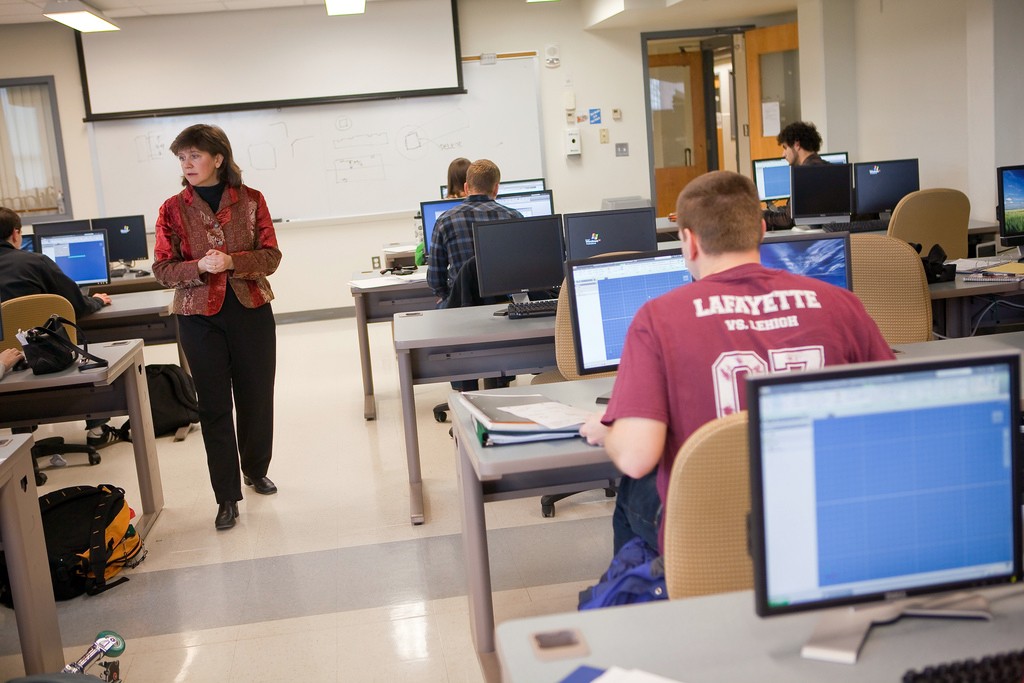Making Strides in Gender Inclusivity
Ongoing Initiatives
Lafayette Engineering has several initiatives intended to help create a welcoming culture for all. Last year prospective female students were paired with Society of Women Engineers (SWE) student chapter members to boost recruiting at the Engineering Open House and Experience Lafayette College events. The division also piloted a shadowing program for high school girls that paired them with Lafayette research students for a multi-day shadowing experience, introducing them to real-world engineering applications. This early context can be encouraging for young women in fields traditionally viewed as male oriented.
Diversity efforts have also made their way into the classroom. ES101, Introduction to Engineering, was restructured with the goal of demonstrating the relevance of engineering and its impact on society, which has been shown by Harvey Mudd to improve gender diversity in STEM1. ES102, Introduction to Spatial Visualization Skills, has been offered for the past few years. The skills taught in this course have been shown to help students perform better across the STEM fields, and have been shown to be particularly helpful in improving persistence of underrepresented groups.
Building a Sense of Community
To encourage women’s success in engineering, the division strives to promote a sense of community. Lafayette SWE t-shirts were distributed to all accepted female students at Experience Lafayette College, creating a cohesive and welcoming culture of women at the beginning of their college careers. An active SWE chapter on campus helps to maintain this sense of connection.

Rebecca Rosenbauer, director of engineering computing, works with students in the Acopian computer lab.
So that women may also feel a sense of personal investment, the division continues to seek research opportunities for underrepresented groups. At Lafayette, undergraduate research experiences are not only highly valued, but have a lasting and consequential impact on participating students, instilling confidence and reinforcing an interest in engineering. Presently Lafayette women engineers comprise one-third of the engineering students doing research. In addition, Lafayette Engineering recently received a Clare Boothe Luce Program grant of $150,000 to expand opportunities for women further and has established the Clare Boothe Luce Research Scholars in Engineering Program.
This inclusive community is further reflected among faculty. The percentage of full-time female faculty members in Lafayette’s engineering program has risen to 22 percent. This compares to the national average of approximately 14 percent, according to the American Society for Engineering Education (ASEE). In addition, four of the five department heads and program chairs in the Engineering Division are women. Lafayette’s female faculty members serve as role models for students and encourage young women to pursue their interest in engineering.
Increase in inclusivity
Lafayette Engineering’s upward trend in gender inclusivity is expected to continue. For the past two decades Lafayette has exceeded the national average of women in its engineering programs, averaging approximately 25 percent over any five-year period. The class of 2019 has approximately 32 percent women, the highest percentage since the College became co-educational. This compares to the national average of approximately 18 percent, according to ASEE.
By continuing to ensure a comfortable environment in which underrepresented groups feel encouraged and supported, providing experiential learning, and promoting opportunities for students to apply their engineering education to real-world problems, Lafayette will continue to embolden women in engineering. “We are confident that this increasing diversity is not a blip but the result of ongoing efforts, and will continue to develop,” says Scott Hummel, William A. Jeffers Director of the Engineering Division.